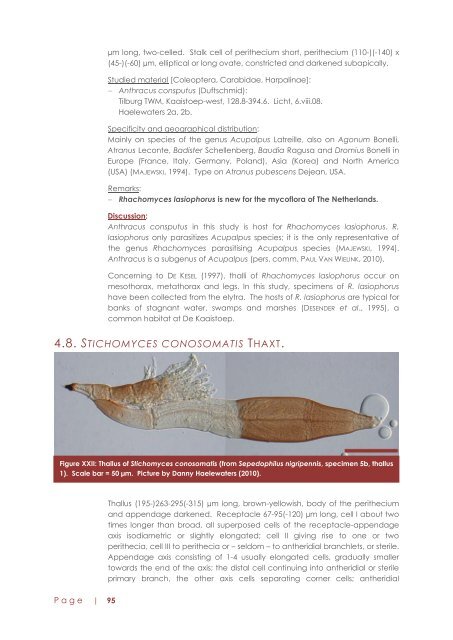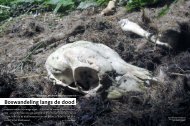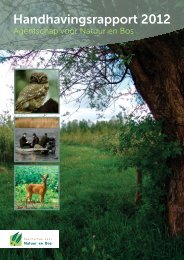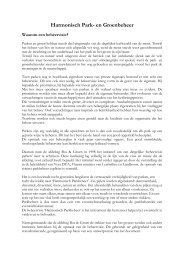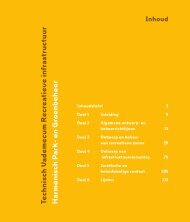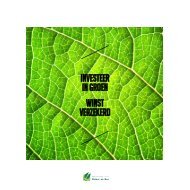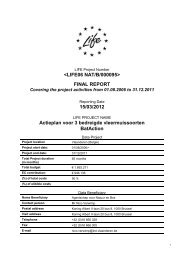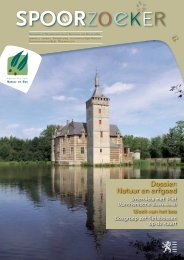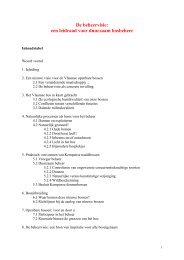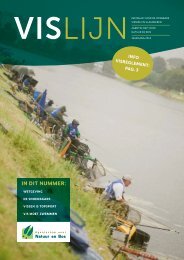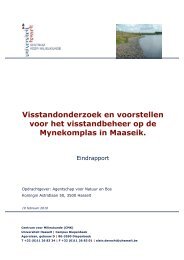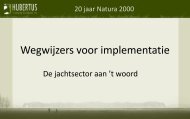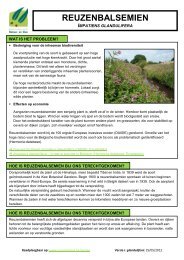µm long, two-celled. Stalk cell of perithecium short, perithecium (110-)(-140) x(45-)(-60) µm, elliptical or long ovate, constricted and dark<strong>en</strong>ed subapically.Studied material [Coleoptera, Carabidae, Harpalinae]:Anthracus consputus (Duftschmid):Tilburg TWM, Kaaistoep-west, 128.8-394.6. Licht, 6.viii.08.Haelewaters 2a, 2b.Specificity and geographical distribution:Mainly on species of the g<strong>en</strong>us Acupalpus Latreille, also on Agonum Bonelli,Atranus Leconte, Badister Schell<strong>en</strong>berg, Baudia Ragusa and Dromius Bonelli inEurope (France, Italy, Germany, Poland), Asia (Korea) and North America(USA) (MAJEWSKI, 1994). Type on Atranus pubesc<strong>en</strong>s Dejean, USA.Remarks:Rhachomyces lasiophorus is new for the mycoflora of The Netherlands.Discussion:Anthracus consputus in this study is host for Rhachomyces lasiophorus. R.lasiophorus only parasitizes Acupalpus species; it is the only repres<strong>en</strong>tative ofthe g<strong>en</strong>us Rhachomyces parasitising Acupalpus species (MAJEWSKI, 1994).Anthracus is a subg<strong>en</strong>us of Acupalpus (pers. comm. PAUL VAN WIELINK, 2010).Concerning to DE KESEL (1997), thalli of Rhachomyces lasiophorus occur onmesothorax, metathorax and legs. In this study, specim<strong>en</strong>s of R. lasiophorushave be<strong>en</strong> collected from the elytra. The hosts of R. lasiophorus are typical forbanks of stagnant water, swamps and marshes (DESENDER et al., 1995), acommon habitat at De Kaaistoep.4.8. STICHOMYCES CONOSOMATIS THAXT.Figure XXII: Thallus of Stichomyces conosomatis (from Sepedophilus nigrip<strong>en</strong>nis, specim<strong>en</strong> 5b, thallus1). Scale bar = 50 µm. Picture by Danny Haelewaters (2010).Thallus (195-)263-295(-315) µm long, brown-yellowish, body of the peritheciumand app<strong>en</strong>dage dark<strong>en</strong>ed. Receptacle 67-95(-120) µm long, cell I about twotimes longer than broad, all superposed cells of the receptacle-app<strong>en</strong>dageaxis isodiametric or slightly elongated; cell II giving rise to one or twoperithecia, cell III to perithecia or – seldom – to antheridial branchlets, or sterile.App<strong>en</strong>dage axis consisting of 1-4 usually elongated cells, gradually smallertowards the <strong>en</strong>d of the axis; the distal cell continuing into antheridial or sterileprimary branch, the other axis cells separating corner cells; antheridialP a g e | 95
anches (15-)34-38(-40) µm long, terminated by 2-5 antheridia which mayproliferate into short branchlets. Perithecium one per thallus, less frequ<strong>en</strong>tly 2-4on both sides of the receptacle; stalk cell as well as secondary stalk cell andone of the basal cells elongated, perithecium (75-)126-130(-152) x (30-)40-43(-45) µm, sl<strong>en</strong>der, with slightly differ<strong>en</strong>tiated neck tapering to narrow, distal partof stalk cell and secondary stalk cell hyaline, rounded apex. Ascospores twocelled,(32-)(-45) x (2-)(-3) µm.Studied material [Coleoptera, Staphylinidae, Tachyporinae]:Sepedophilus nigrip<strong>en</strong>nis (Steph<strong>en</strong>s):Tilburg, TW Kaaistoep. Potval, 13-27.1.2001.Haelewaters 5a, 5b.Specificity and geographical distribution:On species of the g<strong>en</strong>us Sepedophilus Gistel in USA, Algeria, Great Britain,Belgium, Poland, Spain and Japan.Remarks:Stichomyces conosomatis is new for the mycoflora of The Netherlands.Discussion:Most thalli of Stichomyces conosomatis have only one perithecium and none,one or two perithecial primordia. Both TAVARES (1985) and MAJEWSKI (1994)describe the developm<strong>en</strong>t of secondary perithecia upon the cell above cell II.Since cell III basically never bears perithecia (cfr. Part I, 1.3.2. THE RECEPTACLE),this cell should be considered as cell II‟. The thalli studied in this research haveonly perithecia(l primordial) upon cell II, consist<strong>en</strong>t with the Belgian material(DE KESEL, 1997).4.9. STIGMATOMYCES MAJEWSKII H.L. DAINAT, MANIER &BALAZUCFigure XXIII: Thallus of Stigmatomyces majewskii (from Drosophila subobscura, specim<strong>en</strong> 10a, thallus1). Scale bar = 100 µm. Picture by Danny Haelewaters (2010).P a g e | 96Thallus (320-)250-258(-372) µm long, hyaline to brownish-yellow. Receptacle133-148 µm long, sl<strong>en</strong>der, with cell II always shorter than the cell I; cell I long,narrower at the base, remarkably divided in two: granular protoplasmaticmass in the upper part, optically empty hyaline mass in the lower part.App<strong>en</strong>dage (41-)51-76 µm long, its axis consisting of four cells, of which the first
- Page 3:
LABOULBENIALESEXPLORING AND TESTING
- Page 7 and 8:
PART IVPRELIMINARY CHECKLIST OF LAB
- Page 9 and 10:
SAMENVATTINGINLEIDINGLaboulbeniales
- Page 11 and 12:
PART IGENERAL INTRODUCTIONTHESIS OU
- Page 13 and 14:
fifth volume, therefore the sixth v
- Page 16 and 17:
1.3.3. THE PERITHECI UMAscospores o
- Page 18 and 19:
The identity of appendages, togethe
- Page 20 and 21:
Figure IV: Position of Laboulbeniom
- Page 22 and 23:
LUMBSCH & HUHNDORF (2007) distingui
- Page 25 and 26:
Substrate is the intermediate facto
- Page 27:
CAVARA (1899, ref. in BENJAMIN, 197
- Page 35 and 36:
1. INTRODUCTION1.1. DIFFICULTIES FO
- Page 37 and 38:
2. MATERIALS & METHODS2.1. FUNGUS,
- Page 39 and 40:
2.2.6. PROTOCOL V: DIRECT PCROne th
- Page 41 and 42:
P a g e | 38chance. Thus, the lower
- Page 43 and 44:
coll1133 Laboulbenia collae IV 608l
- Page 45 and 46:
Cladosporium (Ascomycota, Dothideom
- Page 47 and 48: 5. CONCLUSION AND SUGGESTIONSMany a
- Page 49 and 50: 1. INTRODUCTION1.1. FORENSIC ENTOMO
- Page 51 and 52: Different groups of carrion beetles
- Page 53 and 54: The 1.319 ha Meerdaal Forest has be
- Page 55 and 56: 2.2. MEERDAAL FOREST(DA TA NA TI O
- Page 57 and 58: approximately 2.700 are found in Eu
- Page 59 and 60: Order ColeopteraSuborder PolyphagaI
- Page 61 and 62: Dermestidae 8 2 23 (3) / 22 (4)Elat
- Page 63 and 64: Table XXIV: Family Cerambycidae fro
- Page 65 and 66: Table XXVIII: Family Dermestidae fr
- Page 67 and 68: Adults prey on other flower-visitin
- Page 69 and 70: Table XXXV: Family Scarabaeidae fro
- Page 71 and 72: Creophilus Samouellemaxillosus (Lin
- Page 73 and 74: 4.3. LABOULBENIALES OF CARRION BEET
- Page 75 and 76: The knowledge about the preferences
- Page 77 and 78: Table XLII: Comparison of carrion b
- Page 79 and 80: 5. CONCLUSION AND SUGGESTIONSNo spe
- Page 81 and 82: 1. INTRODUCTION1.1. NATURAL LANDSCA
- Page 83 and 84: In the 40s, Middelhoek studied and
- Page 85 and 86: 2. MATERIALS & METHODS2.1. HOSTS2.1
- Page 87 and 88: Screening of the insects was done w
- Page 89 and 90: 3. RESULTS3.1. PARASITE-HOST LISTA
- Page 91 and 92: Figure XV: Detail of thallus of Lab
- Page 93 and 94: isodiametric or slightly elongate,
- Page 95 and 96: occurs in the lower receptacle (cel
- Page 97: Discussion:Two species of the genus
- Page 101 and 102: 5. CONCLUSION AND SUGGESTIONSIn The
- Page 103 and 104: P a g e | 100ADRIAENS, T. & GYSELS,
- Page 105 and 106: transmission, habitat preference an
- Page 107 and 108: STALPERS, J.A., VILGALYS, R., AIME,
- Page 109 and 110: MELIS, C., TEURLINGS, I. LINNELL, J
- Page 111 and 112: SCHILTHUIZEN, M. & VALLENDUUK, H. (


